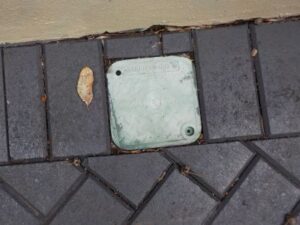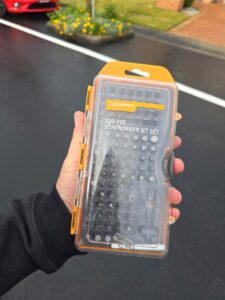Termite Reticulation Systems Sydney
“Do You Need to Re-fill or Re-Charge Your Reticulation System?”
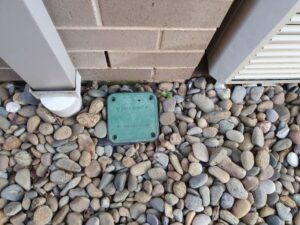
Above Photo: Termguard Box

Termite Reticulation Systems in Sydney
Protect your home with the latest reticulation technology. At A1 Pest Control, we re-charge or re-fill:
- TermX Replenishment System – Flexible design, easy recharge, compatible with Termidor HE
- Termguard – Trusted for decades; strong brand recognition
- Altis – Patented emitter valves for precise chemical delivery
- Camilleri Reticulation – Popular in new concrete pours
- Cavtech in Wall Reticulation System
Subterranean Termite Management System – Termguard Reticulation
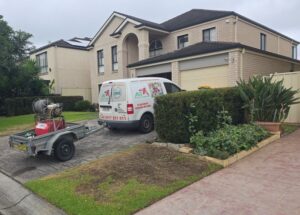
The above photo shows the rig that we use for all of our re-fills.
This green plate is pretty typical and is usually found on either side of the house.
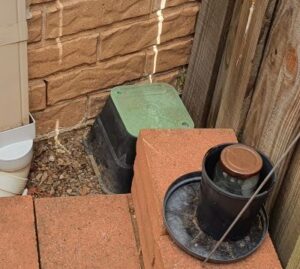
Other times it comes with a housing box underneath like this one.
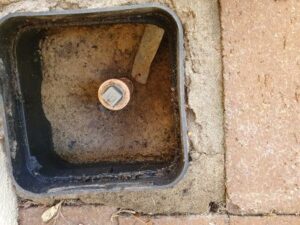
The inlets can come as a single unit

Or more commonly like this one.
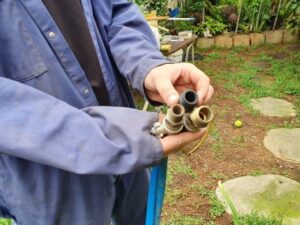
There’s a few different sizes and configurations, but we can cover most of them.

We fit the correct adapter and do the re-filling mainly with Termidor products, according to the wishes of our client. We will always recommend Termidor, as it is the premium product on the market.
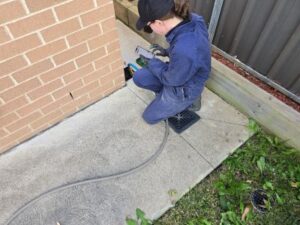
We will always make sure that the correct amount of termiticide is installed at the right pressure according to Australian Standard AS 3660.2.
Advanced Termite Protection with Termguard Systems
At A1 Pest Control Sydney, we use Termguard Systems to provide long-lasting, Australian Standards-compliant termite protection for your home or commercial property. As trained and licensed Termguard installers, we deliver systems that are effective, discreet and easy to maintain.
Termguard System Options
- Perimeter Retreatment & Armoured Shield System: Cost-efficient protection using UPVC shields that resist chemicals, UV and ground movement.
- Perimeter & Penetration Retreatment System: Protects slab edges, service penetrations and construction joints with re-treatable uPVC pipes and childproof injection points.
- Ultimate System: Full underslab network for 100% termiticide coverage, perfect for new builds up to 200 m² per system.
- Sub-Cavity & Penetration Retreatment System: Ideal for split-level or zero-line sites, using Termortar® and a sub-cavity pipe network for thorough protection.
Technical Highlights from the Termguard Manual
- Heavy-duty UPVC Armoured Shields solvent-welded to penetrations, keyed into slab concrete for long-term durability.
- Perimeter and penetration pipes are installed with Permecover sleeves to filter soil contaminants and ensure even termiticide distribution.
- Childproof traps protect injection points, enabling safe re-application over the building’s life.
- Conforms to Australian Standard AS3660 series & Building Code of Australia.
- Injection systems use 20mm drilled uPVC pipes (max length 16m per run) and 40mm feeder manifolds.
- Special installation techniques for monolithic slabs, waffle pods, infill slabs and reactive soils (H or E class).
- Solvent cement welding ensures reliable, leak-proof joints without primer.
Why Choose A1 Pest Control Sydney?
- Over 40 years of local pest management expertise
- Fully trained and licensed Termguard installers
- Eco-friendly solutions that integrate with your landscaping
- Annual inspections and retreatment services
Contact Us
A1 Pest Control Sydney
📞 0417 251 911
📧 bruce@a1pestcontrol.com.au
🌐 www.a1pestcontrol.com.au
NSW Licence No: 5067756
Based on Termguard Technical Manual 2019 Edition 13. A1 Pest Control – your trusted termite specialists in Sydney.
Subterranean Termite Management System – Cavtech Reticulation
As part of the certified termite protection measures under AS 3660.1, this installation uses the Cavtech reticulation system – a proven and flexible termite management solution designed for new building work and extensions.
📄 Certificate of Installation – Key Details
- Barrier system type: Cavtech reticulation system installed in compliance with AS 3660.1.
- Installation date: [Insert date here].
- Registered chemical (if applicable): [Insert chemical name & ACVMA label life expectancy].
- Installer certification: Work completed as per Australian Standard AS 3660.1, with installer name, signature, and contact details recorded on the certificate.
📍 Durable Notice
The durable notice must be weather‑resistant and fixed near the meter box or another visible location, so it remains legible for future owners and inspectors.
✅ Why Choose Cavtech Reticulation?
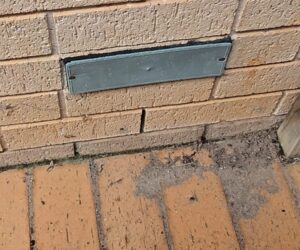
The Cavtech reticulation system allows for re‑treatment of chemical barriers without invasive works, offering long‑term protection and cost‑effective maintenance. This system is particularly suited to perimeter and under‑slab installations in compliance with AS 3660.1.
Cavtech Vs Cavtect – are they the same firm?
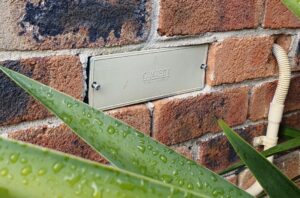
✅ CAVTECH and CAVTECT are not officially the same company or product, although:
Both names relate to termite protection systems, usually involving cavity protection or reticulation systems that allow chemical replenishment.
They both have a similar type of cover, screws and plumbing.
They sound very similar, which causes confusion in the pest control industry and among builders.
What is typically known:
CAVTECH (with an “H”) is usually used to refer to a branded reticulation system for termite management in Australia.
CAVTECT (with a “T,” as shown on your photo) appears to be another proprietary system specifically branded as:
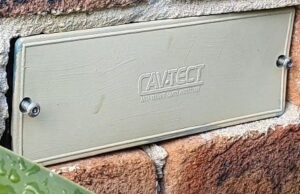
CAVTECT ANTI TERMITE CAVITY PROTECTION
They both aim to achieve a similar function: protecting cavity walls and/or slab edges by allowing termite chemical treatments to be distributed or replenished.
⚙ Are they owned by the same company?
There’s no clear evidence in public ABN or trademark databases (as of my last check) showing that CAVTECH and CAVTECT are registered under the same corporate entity or trademark holder.
They appear to be:
Separate trademarks
Possibly different manufacturers or distributors
Used by different pest control businesses or builders
Both Cavtech and Cavtect can be opened using just one piece of the 100 Piece Screwdriver Bit Set. I got this one from Bunnings at around $10.
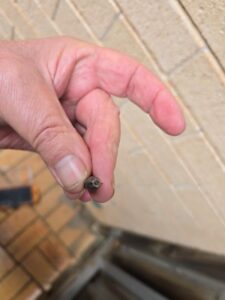
This one is the correct bit, shown between my fingers.
 This is the back of the set with the specifications
This is the back of the set with the specifications
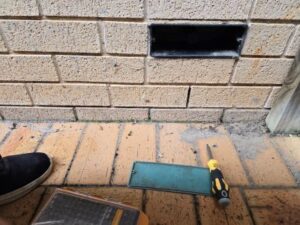 Cover off
Cover off
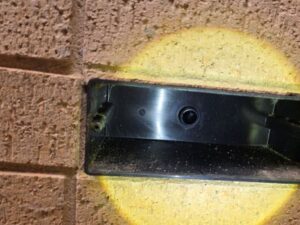 Interior Cavtech Box Illuminated
Interior Cavtech Box Illuminated
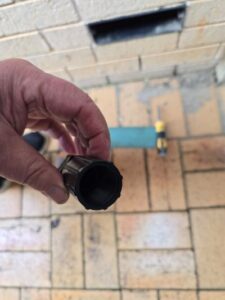 I took this off to get the dimensions for the male piece of our adapter/valve
I took this off to get the dimensions for the male piece of our adapter/valve
 Cavtech Inlet Sideview
Cavtech Inlet Sideview
Why choose us?
- Licensed & insured technicians
- Termidor HE specialists for clay soils
- Recharge reminders to keep your protection active
Don’t wait for termites to find you. Call 0417 251 911 or book online today.
Top 10 Most Effective Termite Protection Products in Sydney
Below is our list of the top 10 most effective termite protection products in my own experience as a termite specialist.
From chemical termite barriers to baiting systems, termite reticulation and physical barriers, these products have proven to work well in Sydney’s termite-prone environment.
- Termidor®: Termidor® is one of the most popular and effective liquid termiticides. It creates a barrier around the property that either repels or kills termites on contact. It’s commonly used by pest control pros.
- Premise®: Premise® is another liquid termiticide known for its effectiveness in treating active infestations. It’s long-lasting, so it’s useful for both pre- and post-construction treatments.
- Trelona® ATBS (Advance Termite Baiting System): Trelona® ATBS is a highly effective baiting system that provides continuous monitoring. It’s great for detecting and eliminating termites over time.
- Sentricon®: Sentricon® is a high-tech termite baiting system. It works by luring termites to bait stations that contain poison, which they then carry back to the colony, eventually wiping it out.
- Exterra®: Exterra® is a termite baiting system that introduces termites to a bait containing a growth inhibitor, killing them over time. It’s an excellent solution for long-term protection.
- Kordon®: Kordon® is a physical termite barrier made from flexible plastic sheets. It’s installed under the foundation of buildings to create an effective, long-lasting protection barrier against termites.
- Homeguard®: Homeguard® is a physical barrier that’s placed beneath concrete slabs during construction. It combines chemicals and plastic to form a robust defence against termites.
- Termimesh: Termimesh is a physical barrier made of fine mesh, designed to prevent termites from gaining access to your home’s structural timbers.
- Nemesis Termite Baiting System: Nemesis utilizes chlorfluazuron to disrupt termite development, leading to colony elimination.
- Greenzone Perimeter System: GREENZONE® Termite Barriers are a hybrid physical and chemical solution, embedded in a non-soil matrix, offering flexible and lasting termite protection for Sydney homes. Installed once, they’re built to endure the full economic life of your building.
Top 50 Most Termite-Affected and At-Risk Suburbs of Sydney
In my experience as the owner of A1 Pest Control, certain suburbs are more vulnerable to termite activity.
This is due to factors like proximity to bush, coastal areas, or the concentration of older buildings.
Below is a list of the top 50 suburbs in Sydney that I found that are most affected or at the highest risk of termites:
- Baulkham Hills
- Castle Hill
- North Parramatta
- Carlingford
- Ryde
- Epping
- Beecroft
- Cheltenham
- Hornsby
- Westleigh
- Cherrybrook
- Wahroonga
- Turramurra
- Mount Colah
- Dural
- Galston
- Winston Hills
- Merrylands
- Greystanes
- Wentworthville
- Auburn
- Blacktown
- St Marys
- Penrith
- Quakers Hill
- Seven Hills
- Prospect
- Kuring-Gai
- Kellyville
- Sutherland Shire
- Cronulla
- Miranda
- Engadine
- Illawong
- Hurstville
- Bexley
- Rockdale
- Kogarah
- Greenacre
- Bankstown
- Punchbowl
- Marrickville
- St Peters
- Newtown
- Darlington
- Annandale
- Leichhardt
- Ashfield
- Strathfield
- Parklea
Protecting your property from termites is critical, especially in areas like Sydney where the risk is higher.
Termites and Their Threat to Buildings
Termites are one of the most destructive pests that can invade a home or building. They feed on cellulose, a material found in wood, and can cause extensive damage to the structure of a building. Termites can enter a building through even the smallest cracks and gaps, including those around weep holes.
There are various species of termites, but the most common types that affect buildings are subterranean termites, drywood termites, and dampwood termites. Subterranean termites are the most widespread and pose the greatest risk to buildings because they live in colonies underground and can enter homes through the soil.
Termites thrive in environments with high moisture levels, which makes weep holes an attractive entry point.
When water accumulates around a building’s foundation or in the wall cavity, termites are drawn to the moisture-rich environment.
Without proper protection, weep holes become easy access points for these pests.
The Importance of Protecting Weep Holes from Termites
Weep holes, while essential for moisture control, can become a significant vulnerability if not properly protected. Termites are highly skilled at detecting areas where water is present and may use weep holes as pathways to enter a building and begin infesting wood framing, flooring, and other structural components.
The absence of adequate termite protection around weep holes can result in:
- Termite Infestation: Termites may enter the building unnoticed through weep holes, leading to a gradual yet severe infestation.
- Structural Damage: Termites feed on wooden structural elements, including beams, studs, and flooring, causing weakening and potentially dangerous structural damage.
- Increased Repair Costs: Treating a termite infestation can be expensive and often requires extensive repairs to damaged structural elements.
- Health Risks: Termite damage may also create environments conducive to mould growth, which poses health risks to building occupants.
Therefore, it is crucial to incorporate termite protection measures when designing and constructing weep holes.
Methods for Protecting Weep Holes from Termites
Several strategies can help prevent termites from entering through weep holes. These methods focus on creating barriers and using materials that deter termite activity while still allowing for moisture drainage. Some of the most common and effective termite protection techniques for weep holes include:
1. Mesh Screens and Barriers
A mesh screen is one of the most popular solutions for protecting weep holes. The screen is made from a fine metal or plastic mesh that fits over the weep hole to prevent termites from entering. These screens allow for water to drain out of the wall while blocking the entry of pests.
In addition to providing a physical barrier against termites, the mesh can help keep out other debris such as leaves, dirt, and insects, which could also obstruct the weep hole’s functionality.
2. Termite-Resistant Materials
Using termite-resistant materials around weep holes can be an effective preventive measure. For example, building materials such as pressure-treated wood, steel, or cementitious products are less attractive to termites and more resistant to infestation.
Incorporating these materials in the construction of the building’s exterior can reduce the likelihood of termite damage even if pests manage to breach the weep holes.
3. Chemical Barriers
Termiticides are chemicals designed to kill or repel termites. Applying a chemical barrier around the foundation and weep holes is another effective way to prevent termite entry. These chemicals can be applied during construction or as part of routine pest control maintenance.
One common method is to treat the soil around the foundation with a liquid termiticide, creating a barrier that termites cannot cross. Additionally, termite bait systems can be installed in conjunction with weep hole protection to provide ongoing monitoring and prevention.
4. Sealants
While it’s crucial to maintain proper moisture drainage, using sealants around weep holes can reduce the risk of termite entry.
In Sydney, two notable termite protection sealant brands that safeguard structures against termite infestations are:
GREENZONE® Termite Sealant: This sealant is designed for application in expansion joints, gaps, and cracks within buildings, effectively preventing termite entry. It pairs well with GREENZONE® Termite Paint and Primer for comprehensive protection.
TERM-seal™ Sealant Active: A highly engineered, acrylic polymer-based liquid that cures to form a seamless, flexible, termite-resistant, and waterproof membrane. It’s suitable for use in joints, cracks, and various construction applications, providing a durable barrier against termites.
Specially formulated sealants can be applied around the perimeter of weep holes to fill any gaps while still allowing water to flow through. These sealants can prevent termites from squeezing through tiny openings that may otherwise go unnoticed.
5. Gravel or Crushed Rock Drainage
In some cases, the addition of gravel or crushed rock around the foundation may be recommended to promote drainage and reduce moisture accumulation. When weep holes are surrounded by gravel, termites may find it more difficult to penetrate the barrier and access the foundation.
This is how Granitgard works:
How Granitgard Works
Physical Barrier: Granitgard is installed around the perimeter of buildings and at slab penetrations during construction. The granite particles create a dense layer that termites cannot chew through or displace .
Non-Toxic Protection: Unlike chemical treatments, Granitgard provides a natural, non-toxic solution, making it safe for both the environment and occupants .
Long-Term Durability: The system is designed to last the life of the building without the need for replenishment or repairs, unless disturbed by activities like renovations or plumbing work .
Inspection Zone: A 75mm clear inspection zone around the base of the building is essential. This area should remain unobstructed to allow for easy detection of any termite activity .
Advantages of Granitgard
Environmentally Friendly: Provides termite protection without harmful chemicals.
Cost-Effective: Offers long-term protection with minimal maintenance.
Flexible Application: Suitable for various building designs and can accommodate structural movements without compromising effectiveness .
Granitgard is widely used in Australia and complies with national building standards, offering a reliable solution for termite management in new constructions.
These materials also help to disperse water more efficiently, ensuring that moisture doesn’t pool around the foundation and attract termites.
These materials also help to disperse water more efficiently, ensuring that moisture doesn’t pool around the foundation and attract termites.
Weep holes are a critical component in building construction in the Hills District, playing a vital role in moisture control and structural integrity.
However, if left unprotected, they can become an entry point for termites, leading to significant damage to the structure.
By implementing effective termite protection strategies—such as mesh screens, termite-resistant materials, chemical barriers, sealants, and gravel drainage systems
—builders can safeguard the property from pest infestation while maintaining the weep hole’s essential function.
Properly protecting weep holes not only helps preserve the integrity of the building but also protects the health and safety of its occupants.
Call Bruce directly from 9am to 5pm Monday to Friday. Or 10am to 2pm on Saturday
Bruce Gow
A1 Pest Control
Opening and Closing Hours:
Monday 8am–5pm
Tuesday 8am–5pm
Wednesday 8am–5pm
Thursday 8am–5pm
Friday 8am–5pm
Saturday 10am–2pm
Sunday Closed
A1 Pest Control has over 40 years of experience in termite protection, termite inspections, and safe termite treatments. Using a combination of effective products, such as chemical termite barriers, baiting systems, and physical barriers, can help reduce the likelihood of termite damage.

Regularly inspecting your property, particularly with termite experts, is vital for termite protection in Sydney, Australia.

